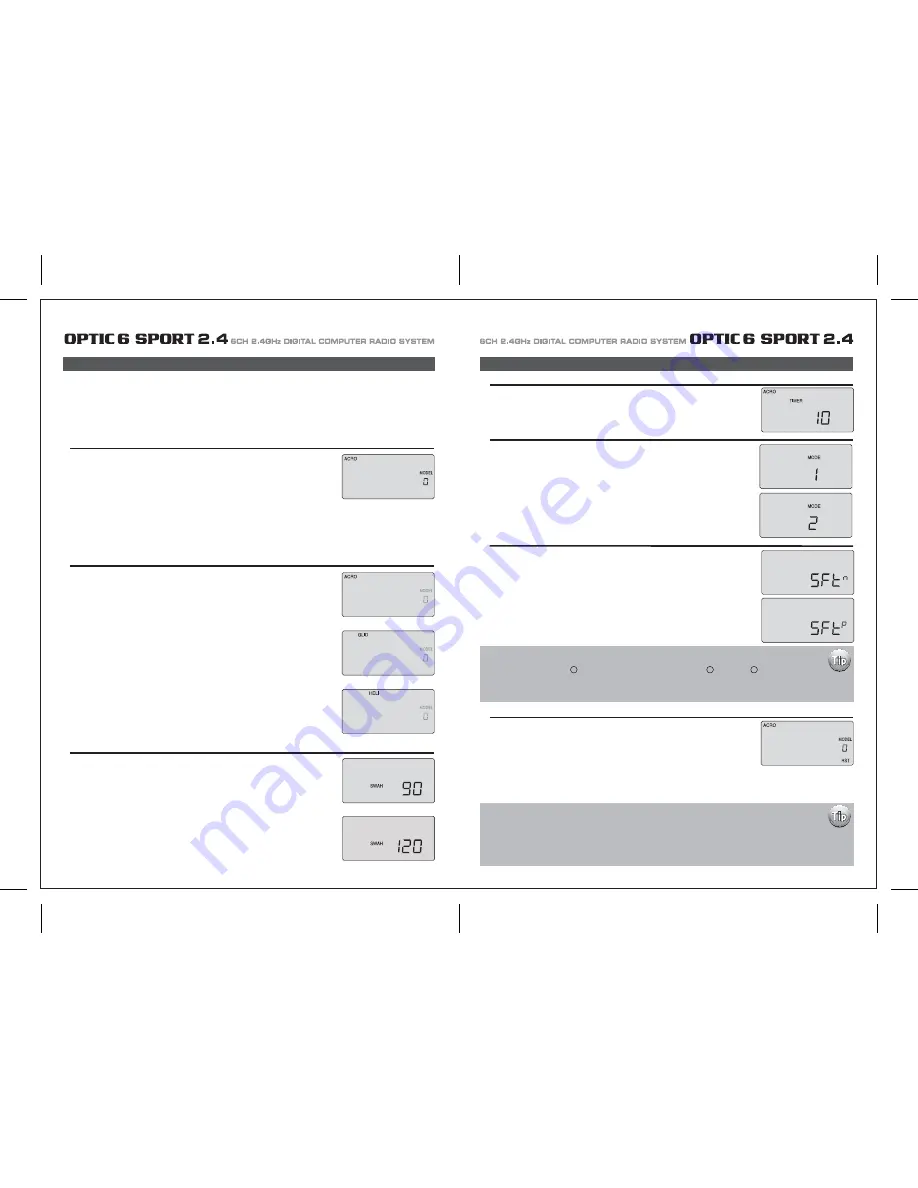
Page 25
Page 26
1. Select a model slot:
4. Configure the countdown timer:
2. Select the Model type programming baseline:
3. Heli Swash Plate:
Before you turn on the transmitter to begin programming one of the model slots for your aircraft, refer to the servo connection chart on page 12,
to see how to plug the servos into their proper channel sockets in the receiver.
Don't turn on the receiver in your model just yet - we'll tell you when to do so.
First we'll get started setting up the aircraft in the Initial Setup program menu, then we'll continue into
the Main Function menu to configure the servo responses and travels of your particular model.
Hold down both EDIT buttons and slide the on-off switch to "on".
The transmitter will beep, the red light will come on, and on the LCD screen you will find yourself in the
first menu item of the initial setup menu.
Under the word "MODEL" the number will be blinking on and off to get your attention.
If this is the first model you are setting up in this transmitter, go ahead and accept this numbered slot by
pushing the right-hand EDIT button to scroll down to the next menu item.
When there are already models inputted, the number that comes up when you turn on the transmitter
will be the last activated model slot.
To change to a different slot, push on one of the CURSOR buttons to go to an empty slot
(consult your list!) and then scroll to the next screen to automatically select it.
In the second menu screen, the programming baseline of ACRO, GLID, or HELI will be blinking.
Since we are setting up a powered aircraft, select ACRO by scrolling to it with a CURSOR button.
Push down both DATA buttons simultaneously to tell the program to accept the choice-you should
hear the transmitter beep twice in acknowledgement.
Now push the right-hand EDIT button to move to the next menu screen.
If you selected HELI as your model type, this screen will appear allowing you to select between
NORMAL (90 degree mechanical) or 120 degree swash plate heli's by pressing one of the
CURSOR buttons.
Find out which one of these popular swash formats your helicopter uses and select it here.
After selecting the appropriate swash type, continue down to the next menu item.
Initial Setup Menu Programming for All Aircraft
Initial Setup Menu Programming for All Aircraft
Now you are at the TIMER menu item with a number blinking away at you-its 10 (minutes) by default.
If you want to set a timer value, go to page 12 for more information on using the timer function.
Otherwise, move down to the next menu item.
5. Select the control's Mode configuration:
6. Select the signal shift:
Under the word "MODE", the number "2" is blinking by default.
Go ahead and accept mode 2 by pushing the right-hand EDIT button to continue to the next screen.
Of course, if you are used to the mode 1 configuration (elevator on the left stick, throttle on the right),
then select number 1. Other changes to accommodate Mode 1 flyers must be done to the transmitter.
Please refer to page 7 for more information.
As indicated by the "SFt" symbol on the screen we are now in the shift selection menu.
The blinking default selection is "n", meaning negative shift.
If your receiver is marked "positive" shift, push one of the CURSOR buttons so that a "P" starts blinking.
Then scroll to the next screen.
7. Reset Screen:
In this screen you should now see a tiny "RST" blinking in the lower right hand corner This means
RESET-and if you push both DATA buttons at the same time that's exactly what will happen: You will
hear a "double beep" and undo all the initial programming we just did, returning all the programming to
the factory's default settings!
Now push the Right EDIT button to scroll right back where we started when we first turned on the transmitter.
We are now done with the initial setup programming of your aircraft, so switch off the transmitter.
When you switch it on again without holding down both EDIT buttons the transmitter will open up in the current model slot (the one we just
programmed) with all the initial settings we just programmed in effect.
The Optic Sport features a powerful option allowing you to select between a Negative or Positive signal
transmit shift. This allows you to use any brand of modern FM receiver.
As a general rule, Futaba R receivers are "Negative" shift, while JR R , Airtronics R and most Multiplex
receivers are all Positive shift.
All models of Hitec receivers have been offered in both shift versions, while newer Hitec receivers are now
"auto shift selectable" and automatically know what shift the transmitter is.
At this point you have selected the type of model ACRO, GLID or HELI, you wish to set-up.
In the manual text that follows, we will review and explain the Model Setup Menu of the three different
model types.
The first is ACRO, followed by GLID, then HELI. All ACRO features will be described in detail within the ACRO section.
Within the following GLID and HELI sections, only features exclusive to GLID and HELI programming will be
described in detail.
For those GLID and HELI features common to ACRO, we will refer you to their description within the ACRO section.





























